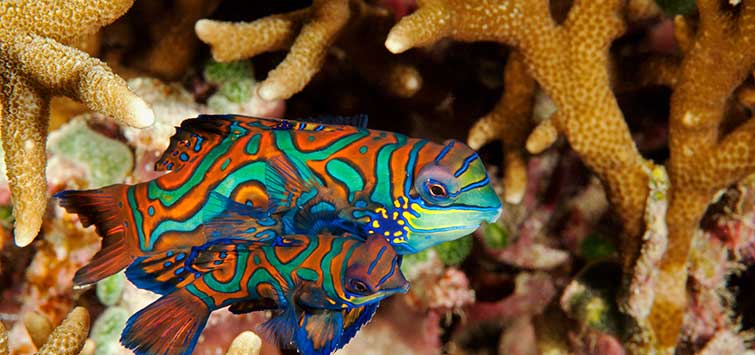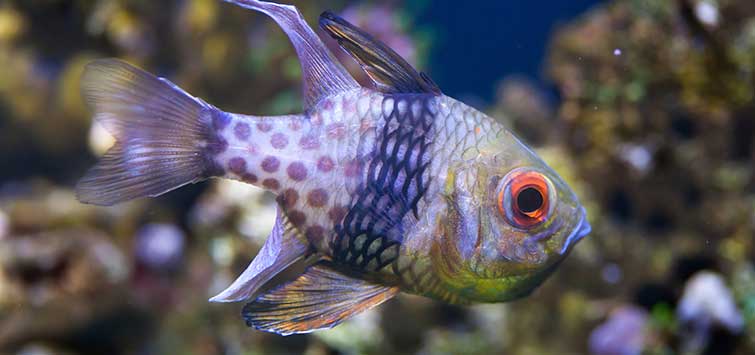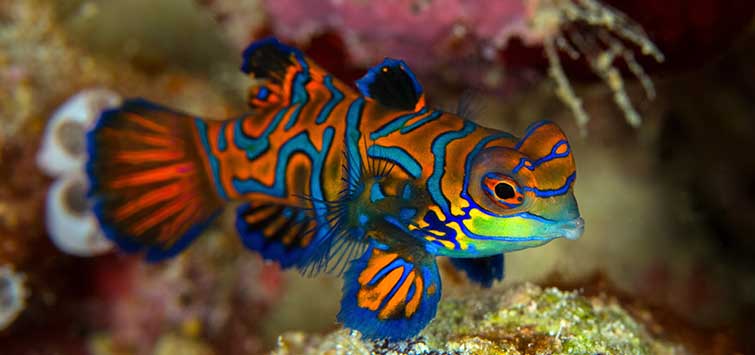Breeding Mandarins
Author: Matthew L. Wittenrich
Mandarins, once considered all but impossible to keep alive, have been captive-bred by the author, who developed a protocol for their commercial production.
The Challenge of Breeding Mandarins
Nearly three years ago I embarked on a challenge that would prove to be one of the most rewarding experiences I have undertaken as a marine researcher and hobbyist: I was inspired to breed mandarins.
When I conceived of this idea, I was a bit concerned whether I could successfully keep the adults alive, let alone spawn and raise large numbers of offspring. When I was 15, my first attempt to keep a mandarin alive resulted in drawn-out emaciation and the ultimate death of one of the most beautiful marine aquarium fishes I had ever seen. But though I vowed at the time never to buy another and watch it meet a similar fate, I moved forward.
Dragonets
Fueled by curiosity and the observations and success of fellow hobbyists before me, I succeeded in raising four species of dragonets: the green mandarin Synchiropus splendidus, spotted mandarin S. picturatus, red scooter blenny S. stellatus, and scooter blenny S. ocellatus. I have learned a great deal about the behaviors and captive requirements of dragonets over the last few years and continue to explore new insights into their reproduction and larval development.
Dragonets are undeniably popular among aquarium enthusiasts, divers, and photographers. A wealth of information and personal anecdotes are available from aquarists around the world describing what they consider are the best methods for the long-term success of dragonets. To better understand how to keep dragonets alive and healthy in aquariums, it always helps to understand a little more about their biology. Understanding the biology of the fish we keep often adds to the value of our hobby and the connection we feel with the fish in our care.
Mandarin Background
Dragonets, including mandarins, belong to the family Callionymidae, a family of small bottom-hopping fishes that rarely exceed 4 inches. Overall, the family contains about 187 species in about 15 different genera. There are approximately 40 species of dragonets in the genus Synchiropus distributed throughout the tropical Indian and Pacific Oceans.
The green and spotted mandarins are most abundant in shallow protected lagoons, where they occur over coral-rubble bottoms and within the labyrinth of branching corals and rocky caverns. They are generally crepuscular and venture into the open during dawn foraging forays and dusk spawning events. Scooter blennies are not as cryptic; they occur over sandy and rubble bottoms, often over loose grass beds or algae-covered rocks in which they forage.
Spawning Sites
According to Yvonne Sadovy, a research scientist at the University of Hong Kong, green mandarins come together shortly before sunset at designated spawning sites on the reef. Generally, divers find one large male courting and spawning with up to three females on small lagoon rock and patch reefs.
Larger, more continuous reefs often have multiple congregation sites where multiple males stage and quarrel over breeding rights. In these situations, females select the largest males to mate with. The wild fishery for mandarins is highly selective, targeting the largest fish from the social groups. As the large males are removed for the aquarium trade, females are forced to mate with smaller males. Sadovy’s observations suggest that as females mate with smaller, less-experienced males, the pair becomes prone to predation during drawn-out spawning ascents—yet another reason to promote captive-bred stock.
10 Tips for Breeding Mandarins
Here are 10 things that I have learned along the way to successfully breeding mandarins:
1.Mandarins are Collected with Mini-Spearguns
Sadovy and other researchers suggest that mandarin populations have been driven to commercial extinction in some areas, and that collection for the aquarium trade may not be sustainable. Mandarins are collected with mini-spearguns that fire long, double-pronged sewing needles into the side or tail of the fish.
A few years ago I kept a large male dubbed “stubby” that showed obvious damage to the posterior vertebrae. He lived for a few years, though his swimming and feeding was obviously affected by this damage. I have since seen several large males at wholesalers with similar damage to the vertebrae.
Assuming the spears do not damage vertebrae or puncture the visceral cavity, there are no long-term consequences to this collection method. Scooter blennies and red scooter blennies are typically caught with hand nets, as they occur over rubble and loose grass bottoms.
2. Why Pairs Don’t Get Along
Eating takes precedence over reproduction. The most common reason heterosexual pairs do not get along is poor body condition. The journey wild mandarins must take to arrive at the local pet shop is a long one that generally results in tremendous deterioration of fat reserves and emaciated body condition. Though reproduction is a strong driving force in the life of mandarins, feeding comes first.
Outside of reproductive periods, green mandarins are generally solitary and forage throughout the day on foods high in lipids. Their digestive systems are short and efficient at stripping foodstuffs with large amounts of fatty acids, such as copepods. When mandarins first arrive from the local shop it is important to get them feeding and boost their fat reserves. Once they are full bodied, reproduction will again become a priority.
Another reason pairs sometimes do not get along is size. Wild observations suggest that females prefer the largest males. In pairs where the male is smaller than the female or of similar size, the female often attacks the male. If pairing green mandarins is a priority, choose the largest male or a pair with a marked size difference and introduce them only after they are well conditioned.
Spotted mandarins are a bit different. Males and females generally do not exhibit marked size differences, and the only way to tell the sexes apart is the elongated first dorsal spine of males, although this characteristic is very subtle. The exaggerated dorsal is far less obvious than that of the green mandarin. While the male’s elongated spine is often damaged during collection and shipping, its dorsal fin will usually still appear somewhat pointed. Match the appearance of the dorsal fin with behavioral observations, and it will soon become obvious if a heterosexual pair is present. Male-male pairs will fight incessantly.
3.Mandarins have a Second Set of Jaws
Since dragonets originate from Southeast Asian archipelagos, going from collector to exporter to importer and eventually the local fish shop, their body condition is generally weakened to the point of no return by the time your eyes hit them in local shops.
Most words of wisdom from aquarium texts say not to buy thin, emaciated, and lethargic fish. This is terrific advice, but very few mandarins at retail shops meet the criteria of “full body.” It is important to get mandarins eating as soon as they arrive, but what do you feed them? Mandarins are often viewed as delicate feeders that consume nothing but tiny copepods crawling around on live rock that they suck up with their small, down-turned mouths.
Have you ever seen a mandarin eat a snail? What about a shelled opisthobranch? The diet of wild mandarins is incredibly diverse; they forage on things we ordinarily would never think of. In the throat of mandarins is a second set of jaws (pharyngeal jaws) used to crush and masticate hard-shelled prey, such as the shells of snails and small hermit crabs. These pharyngeal jaws are connected to robust muscles that widen the breadth of the diet of these fish.
Weaning mandarins onto captive diets is gaining in popularity, and there are reports of mandarins eating everything from frozen mysis shrimp to pellet foods. In my opinion, nothing beats mysis shrimp for putting weight on fast and keeping mandarins in peak reproductive and physiological health—but don’t forget about the snails and other creatures in your tank!
4. Photoperiod Affects Breeding
The best way to watch your mandarins breed is with a regular light schedule. Dragonets display a number of false spawning ascents before a single successful ascent that results in the release of eggs. This breeding behavior is fascinating to observe and adds to the endearing nature of the fish and the captive environments we aim to create.
Assuming a heterosexual pair of dragonets is housed in the same aquarium, little is required to coax them into spawning. Feed them well and maintain a cyclic light cycle and before you know it, you will observe your mandarins spiraling toward the surface. I generally use a two-bulb light setup that provides an hour of dusk and dawn with an actinic bulb. Set the main photoperiod to 12 to 14 hours of light and the reproductive rhythm will soon sync to the lights.
5. They Can Spawn More than Once a Night
Green mandarins can spawn twice per night. Most literature suggests that pelagic spawners rise high into the water column releasing buoyant eggs at the height of spawning ascent before dashing back to the safety of the bottom. These spawning rises occur most often at or just before sunset, and most experts suggest this is to limit egg-eating predators from seizing the spawn.
For the first year, before I knew mandarins could spawn multiple times per night, it was easy for me to predict the time they would spawn to within about 10 minutes. I usually set pairs up with two bulb setups: one bright bulb with a 6500 or 10,000 K, and one actinic bulb to provide an hour of dawn and dusk. Most pairs would spawn within 10 minutes of the bright lights going out. Spawning frequency, though, seems to be linked to feeding—when well-fed, green mandarins will spawn every night to every three nights.
One night, while collecting a batch of green mandarin eggs, I watched the pair spawn a second time in the beam of my flashlight. Thinking this was an artifact or anomaly, I checked the pair the next night and the pair spawned twice yet again. Checking my notes, I timed this phenomena with the switch to a proprietary brand of mysis shrimp in their diet.
6. Tiny Larvae Require Tiny Foods
A long-standing assumption about raising mandarins and most other pelagic spawners is that to do so, a magic food item is required—one that is small and exhibiting some unknown movement pattern that elicits a strike from any larva seeing it. The search for this magic food has consumed the imagination of many breeders, and often the search has overshadowed a much more important aspect of larval fish biology: creating an environment that elicits a feeding response from the larvae.
Bill Addison raised green mandarins at his C-Quest facilities in Puerto Rico using a small strain of rotifer. Yvonne Sadovy from Hong Kong raised mandarins using copepod-dominated wild plankton, and Julian Sprung used infusoria from locally collected tidal algae. Wolfgang Mai and Sylvio Heydenreich used captive plankton collected from their reef tanks.
Mandarin larvae, while small, will consume a wide variety of zooplankton organisms. A few years ago I set out to test a theory that mandarins could be raised solely on captive foods and in small spaces that the average hobbyist in Nebraska would have access to. I stocked 50 eggs into a one-gallon glass mason jar and fed them rotifers and sea hare Bursatella leachii larvae. Twenty days later, I had 36 juvenile mandarins hopping around on the bottom of the jar.
The key was creating a slowly moving water mass that kept the larvae and their food in the same general area. The Mason jar was tilted slightly on its side so that water would actually spill out into a collection container below it. I then used a piece of flexible airline tubing to drip water in the back of the jar. This forced the water to the mouth where it exited through a screen and into the container below—a slowly moving river where the larvae could remain stationary while their food came to them.
7. Scooters Are the Most Difficult Dragonet to Raise
Dragonet larvae are some of the smallest fish larvae found in the oceans and certainly present challenges to would-be breeders. With a bit of ingenuity and dedication, mandarins can be raised in captivity. Spotted mandarins reach metamorphosis at around 12 to 14 days. In comparison, metamorphosis in scooter blenny larvae seems to require about 20 to 25 days. The larvae of scooter blennies are difficult to feed and are prone to mass mortality before 12 days.
8. They Take More Than a Year to Reach Sexual Maturity
Mandarins reach sexual maturity in 14 months. Sexual dimorphism in green mandarins is visible around six to eight months of age, when the first two dorsal spines of males begin to elongate. Males become increasingly intolerant of one another at around eight months of age. It first starts as a circling behavior and exaggerated swimming, bluffing their opponents. In growout tanks, multiple males will often ball up in group sessions of mock battles. Little harm is done when the fish are young, but after a year the fights become more severe and goal oriented.
My first successful spawn from captive-raised offspring occurred around 14 months of age. The eggs and fecundity were quite small, but fertile nonetheless.
9. Captive-Bred Fish Eat Captive Diets
Captive-bred mandarins eat pellets!For the breeders and commercial facilities that set out to raise large numbers of mandarins, the goal is to wean them to accept prepared foods. This is an incredibly difficult task, but the rewards are far-reaching in the aquarium industry as well as the conservation status of wild populations. No longer do hobbyists have to scratch their heads and wonder if the mandarin they are looking at in the local fish shop has a chance of surviving or meets the full body and alert disposition criteria. Captive-bred mandarins have a much higher chance of surviving in novice aquariums.
10. Captive-Bred Mandarins Are Here!
The buzz is everywhere. One of the marine aquarium’s leading icons has been raised commercially. The beautiful and delicate fish with stripes and swirls of reds, blues, greens, and turquoise will soon be available as captive-bred offspring that do not succumb to the collection pressures of their wild cousins. I am happy to have contributed to this end, and I urge hobbyists to support these captive alternatives.
Against All Odds
Even a few years ago, raising mandarins on a commercial scale was never thought possible. The greatest achievements of leading marine breeders rarely resulted in the numbers necessary for commercial viability. Even if mandarins could be raised, few thought it would be viable on a large scale because they grew so slowly. But against all odds, the two most popular species of mandarins are now being produced.
For more information, please visit the Marine Ornamental Fish and Invert Breeders site at http://www.marinebreeder.org.
See the full article on TFH Digital http://www.tfhdigital.com/tfh/201009/#pg77

.png?h=595&iar=0&w=2781&hash=5FD5E69473BCC22199FBFA2FB71B6033)



